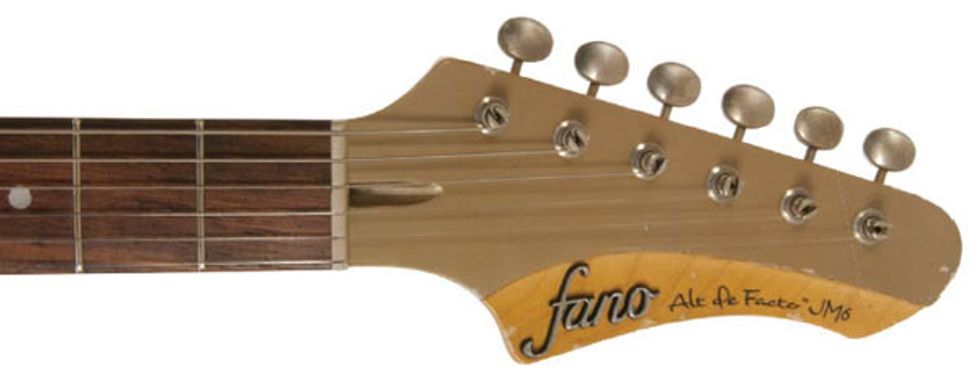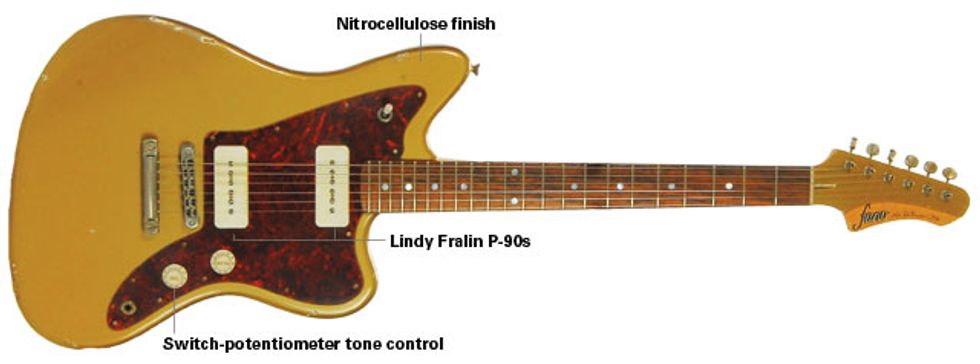| Download Example 1 Neck pickup | |
| Download Example 2 Bridge pickup | |
| Clips recorded direct through Fender '63 Reissue Vibroverb | |
Fano’s achievements are partly attributable to a design philosophy rooted in combining the best features of classic American electric guitars. And the JM6 is a perfect embodiment of that mix-and-match approach. While it’s Jazzmaster inspired at a few paces, its Lindy Fralin P-90s, Tun-o-matic-style bridge, stop tailpiece, and carved, angled headstock effectively make it much more akin to a non-reverse Firebird in terms of tone and personality.
Well Worn
If you like your distressing job to look like it’s done hard time, Dennis Fano is your guy. One peek at this alder-bodied JM6 finished in nitrocellulose “shoreline gold,” gives you the sense that Fano looks forward to that part of the day when he can lay down his intonation and neck-adjustment tools and give his guitars a damn good thrashing. There are some spots—particularly the upper bout where a Jazzmaster’s contours are subject to wear from the friction and sweat of a player’s forearm—that look slightly less convincing and more the product of skilled sanding and thinning. But on the whole, the JM6 looks loved to death—a veteran of knocks on tight stages and spills in cluttered rehearsal spaces. The hardware, which includes TonePros Tune-omatic- style bridge and stop tail piece, and Gotoh reproductions of vintage Kluson tuners, is also pitted and oxidized in a manner that looks perfectly consistent with the battle-scarred body.
The maple neck is a thing of beauty. It’s carefully sanded (worn) to feel as comfortable as a battered pair of sneakers, and it’s fast and silky, with a beautiful, narrow “C” profile that feels a lot like an early ’60s Telecaster. It’s joined with the body using a cool carve and a compact neck plate that facilitates access to higher frets on the treble side.
Getting Dirty
If you love P-90 tones, but dislike the heft of the mahogany slabs with which they’re typically paired on a solidbody, the JM6 will be a delight to sling over your shoulder. It’s a super-light guitar—at least as light as the most featherweight Fenders I’ve played, which can vary in heft considerably—but it is very well balanced. And it’s quite possible that the lighter alder body also has a great deal to do with the JM6’s bright, hot-rodded sonic personality.
To explore the JM6’s voice I plugged it into a Fender Vibroverb 2x10 reissue (they make a very handsome pair, I might add), as well as a silverface Twin Reverb. Predictably, the JM6’s P-90s conspired with the 40-watt Vibroverb and the 10" speakers to kick out a snarling and dirty range of sounds. Before long, I found myself on the bridge pickup working some skanky, suspended Chris Robinson-style riffs in open-G tuning. The Fralin P-90s thrived in the open tuning, communicating overtone detail that many pickups would lose amid the grit.
If you love P-90 tones, but dislike the heft
of the mahogany slabs with which they’re
typically paired on a solidbody, the JM6 will be
a delight to sling over your shoulder.
Sonically, there just isn’t much to complain about with the JM6. The Fralin P-90s are hot, and things can feel and sound a little full-throttle if you’re used to the low output single-coils of a vintage Fender. The light alder body also seems to impart a brightness that can get less than subtle in quieter arrangements and which requires careful use of the tone knob—often a challenge given that Fano opts for a ToneStyler on the tone control rather than a standard sweep potentiometer. That said, you’ll probably never find yourself sounding too muddy playing the JM6.
I did experience some issues with tuning stability on the JM6, which could probably be abated to some extent with heavier strings than the .010-.046 set that the guitar is shipped with. But in many cases, it seems more attributable to a certain amount of flex in the neck that will likely be familiar to vintage SG and non-reverse Firebird players. The upside is the expressive potential of all that leverage—you almost don’t miss a vibrato system if you’re used to one. The downside is that it can be hard to resist leaning on the guitar to get that modulation (it just sounds so cool), and you may find yourself stomping on your tuning pedal somewhat regularly.

The Verdict
The Fano JM6 is a fantastic rock ’n’ roll machine. It’s light and comfortable, with a beautifully fast and satin-smooth neck that invites fast power chording and ripping legato and finger vibrato moves. The hot Fralin P-90s have the ability to make you forget you ever had an overdrive pedal on your board. And the body imparts a top-end kick that works as well as a treble booster for certain leads and arpeggios. At the same time, the JM6 loves a fuzz box. And it’s equally at home with low-watt amps, where it barks and struts with an other-side-of-the-tracks swagger, or highceiling rigs where it shows off its capacity for bell-like clarity.
The price can seem steep, especially if you like new guitars to look new. On the other hand, finding a neck as comfortable as this distressed bit of maple could take years. And few guitars, regardless of price, so successfully marry the balance and feel of a vintage Fender with the rowdy bellow of a ’60s Gibson. Given Dennis Fano’s skills, I wouldn’t be surprised if this design sees further refinements in the years to come, and becomes quite a monster in the process.
Buy if...
you dig gritty P-90 tones, comfortable contours, and distressed aesthetics.
Skip if...
you prefer different tones and putting your own wear and tear on your instrument.
Rating...
Street $2495 - Fano Guitars - fanoguitars.com |








![Rig Rundown: Russian Circles’ Mike Sullivan [2025]](https://www.premierguitar.com/media-library/youtube.jpg?id=62303631&width=1245&height=700&quality=70&coordinates=0%2C0%2C0%2C0)

















